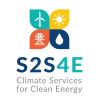Several researchers have been involved in improving the forecasts within the S2S4E Decision Support Tool. This work has included combining the forecasts with observational data and analysing past forecasts and how the weather impacts power production and demand.
“Climate change is expected to lead to more extreme weather and to more frequent extreme weather events, and it is important to take this into account when making predictions about the weather to come over the coming weeks and months,” explains climatologist Irene Cionni.
“That is what is being done with the forecasts within the new forecasting tool developed by the S2S4E project, the S2S4E Decision Support Tool, and which makes the tool different from other existing weather services,” says Cionni.
In addition, the forecasts that are fed into the S2S4E Decision Support Tool – which come from the European Centre for Medium-Range Weather Forecasts (ECMWF), one of the world’s six leading weather agencies – “are combined with observed data”, she says.
Cionni is one of the researchers involved in the S2S4E project, and works at ENEA, the Italian National Agency for New Technologies, Energy and Sustainable Economic Development.
Reanalysis
The climatologists, meteorologists and hydrologists involved in the S2S4E project have analysed past forecasts and compared these with historical data of observed weather to see how accurate the forecasts have been, and to study under which conditions they have proved to be the most reliable, Cionni explains.
“We have used reanalysis in many parts of this project, such as for the calibration of demand models and for the historical data, and it is also used for the evaluation of the forecast skill within the S2S4E Decision Support Tool,” she says.
“Reanalyses are a combination of numerical model results and data on past observations coming from several different sources. We have also analysed six reanalysis products coming from centres located across the globe and compared these with independent datasets of on site and satellite observations,” Cionni says.
The scientists involved in the S2S4E project have also used reanalysis data to calculate averages for the different weather variables, such as precipitation, temperature, wind speed and solar radiation. This data is also fed into the Decision Support Tool to show how the forecasts compare with historical data and if the forecasts are in line with the seasonal norm, or higher or lower than average.
Weather regimes
When investigating under which conditions past forecasts have proved to be the most accurate, the researchers involved in the S2S4E project have studied teleconnections – which are climate anomalies that are related to each other at large distances – and weather regimes – which are patterns based on meteorological conditions.
Both weather regimes and teleconnections “have prevalent effects on the weather in different regions of the world in different parts of the year”, Cionni explains.
“We have also studied the impact of teleconnections and weather regimes on the generation and demand for energy in Europe, and created a map which shows what the impact of each of the weather regimes is for the energy sector,” says Cionni.
“Both energy demand and the production of renewable energy are highly weather-dependent. Temperature affects the demand for energy, while solar radiation, wind speed and precipitation impact how much electricity is produced from solar panels, wind turbines and hydropower stations,” she adds.
First systematic analysis
Moreover, the research results produced as part of the S2S4E project represent “the first systematic scientific analysis of sub-seasonal and seasonal forecasts and the impacts of weather on energy production and demand,” Cionni explains.
“When analysing the data, the scientists involved in S2S4E have taken the information the energy partners in the project know and use, and the outcome is not only scientific research, but really a climate service for the energy sector, namely the S2S4E Decision Support Tool,” she adds.
The S2S4E Decision Support Tool will be free to use until the end of 2020 and is available at s2s4e.eu/dst.
Written by: Iselin Rønningsbakk / CICERO Center for International Climate Research.


